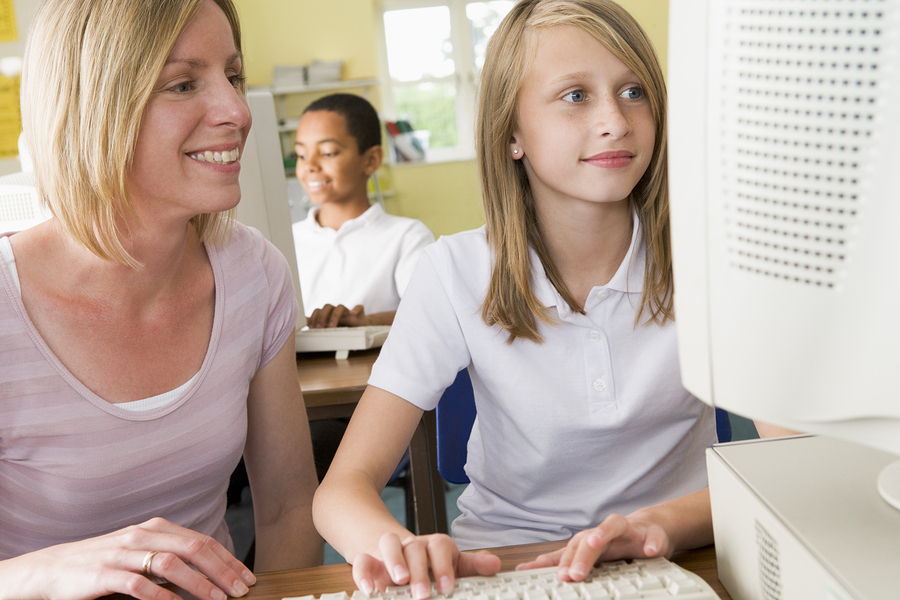Teachers face a myriad of challenges in today’s classrooms. There are numerous disruptive distractions that are fueled by things like cell phones, iPods, or other digital devices.
The stealth use of electronics in a classroom is only trumped only by students who enjoy socializing a bit too much–and there are of course those students that have legitimate learning or developmental disabilities, which make it challenging at best when it comes to staying focused in class.

Maintaining the attention of students requires strong classroom management strategies.
What is the best management strategy for a classroom of students? How does a teacher maintain the upper hand and ensure students are engaged and learning the required curriculum? The key is implementing an effective strategy to keep students focused and on task throughout their entire time in the classroom.
The First Step to Better Student Focus
Teaching is not possible if your students have digital distractions in hand, so before you even begin, as soon as students settle into class, you should create a way to ensure that all devices are put away.
Some teachers have created a “cubby” system of sorts (essentially, name-labeled small storage spaces) where each student must place their cell phones and any other devices as they enter the classroom. They may not reclaim their phone or device until class is over. Getting the devices out of the students’ hands allows the teacher to fully engage students and maintain student focus throughout the class.
Classroom Management Strategies
Once a teacher has his or her students’ undivided attention, it is time to focus on the current lesson plan, but there are other challenges that arise when it comes to keeping the upper hand and general classroom management.
Here are a few ideas to try:
- Communicate and Maintain Authority: Many teachers discover that how well they maintain their authority over the classroom has much to do with the way that they communicate with their students in class. It is important to not to yell, but use a natural speaking voice. Remain silent and in control until students are quiet and do not hesitate to use non-verbal communication, like making eye contact with a student who is chatting or distracted. Some teachers explain from the beginning of the year that certain hand signals or them turning the lights on and off are signals for students to quickly quiet down and pay attention.
- Set Expectations and Routines: It is vital to establish expectations and a natural flow to each class period. Schedules that are chaotic often will open the door to student distractibility. Students will (for the most part) self-regulate to stay on task if they have structured routines, activities, and procedures that they know how to follow. Students feel more in control and tend to stay more focused when they know exactly what they need to do and that it is expected of them to do it.
- Address Behavior Issues Right Away: A vital part of maintaining your authority is dealing with behavior issues immediately and with the correct approach. Never engage in an escalating argument with a student and don’t allow the issue to be entertainment for the class. Pull the student aside or out in the hall and ask questions rather than make accusations about what just transpired in the classroom. If there is a conflict with two or more students, meet with them during a break or after school to discuss what occurred. It is important to serve as a mediator in this situation. Speak calmly in a neutral, non-accusing language. The tone of voice a teacher uses can lead toward a more peaceful resolution where all students feel heard and understood.
- Always be constant with consequences: Establish rules and fully explain the consequences for breaking those rules. Then, always follow through to implement and enforce what you established.
- Utilize Interactive Learning Projects: One solution to satisfying the digital demand students feel vying for their attention is for teachers to implement the technology into classroom lessons and projects. There are many interactive learning components that engage students in a way that makes learning seem more like creative fun.
For example, a writing project that includes publishing students’ work into a real book. Studies show that kids who learn how to write their own stories well, also develop methods to better organize their thoughts, and even communicate better. Writing skills lead to better reading and comprehension skills, and all of this adds up to greater success for the students involved.

If students love electronic devices, make them a part of the learning process.
There are a few publishing options out there for educators to use for free, and students do best with a format that is easy to use, like Bookemon.com, one of the first to cater to teachers with a special edCenter, which allows students to write, create, and publish their own book with impressive, professional results.
Students can publish works of fiction, non-fiction, a memoir or even a comic book. Even class photos can be preserved into a keepsake book for purchasing. The free software provides endless possibilities to publish virtually any type of book.
This is one of the best creative tools for gifted students to go above and beyond regular curriculum. Even older students can write and include images to create and share books of any length. Any independent research or writing project can become an interactive book. Even advanced science experiments and lab reports can be shared online using this tool. Inspire your gifted students to create literary magazine or even a personal online “portfolio” of writing, artwork, or photography presented in interactive book form.
Commenting via TeachersFirst, an online community dedicated to educators, one Pennsylvania teacher who tried it with her own class stated, “This is one of my all-time favorite creative tools. Very versatile. Great for making “buddy books” or for teacher-created learning “books.” I even use it personally to make free online “gifts” for children I know. I did purchase one print version, and it looked great.”
Taking Control
What most experienced educators say is that effective classroom management and keeping students focused is possible if you focus on communication and authority, addressing behavior issues head-on, being consistent with consequences, and implementing interactive learning activities.
Essentially, maintain control in respectful ways and tap into learning opportunities that are geared for what students are excited by in this digital age. Try it out with a creative, digital project today by implementing a writing and publishing activity, and see how students engage and maintain focus.